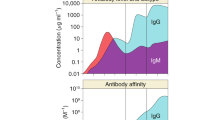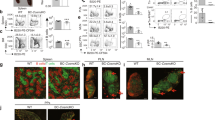Abstract
The interaction of CD22 with α2,6-linked sialic acid ligands has been widely proposed to regulate B lymphocyte function and migration. Here, we generated gene-targeted mice that express mutant CD22 molecules that do not interact with these ligands. CD22 ligand binding regulated the expression of cell surface CD22, immunoglobulin M and major histocompatibility complex class II on mature B cells, maintenance of the marginal zone B cell population, optimal B cell antigen receptor–induced proliferation, and B cell turnover rates. However, CD22 negative regulation of calcium mobilization after B cell antigen receptor ligation, CD22 phosphorylation, recruitment of SHP-1 to CD22 and B cell migration did not require CD22 ligand engagement. These observations resolve longstanding questions regarding the physiological importance of CD22 ligand binding in the regulation of B cell function in vivo.
This is a preview of subscription content, access via your institution
Access options
Subscribe to this journal
Receive 12 print issues and online access
$209.00 per year
only $17.42 per issue
Buy this article
- Purchase on Springer Link
- Instant access to full article PDF
Prices may be subject to local taxes which are calculated during checkout






Similar content being viewed by others
References
Tedder, T.F., Tuscano, J., Sato, S. & Kehrl, J.H. CD22, a B lymphocyte-specific adhesion molecule that regulates antigen receptor signaling. Annu. Rev. Immunol. 15, 481–504 (1997).
Erickson, L.D., Tygrett, L.T., Bhatia, S.K., Grabstein, K.H. & Waldschmidt, T.J. Differential expression of CD22 (Lyb8) on murine B cells. Int. Immunol. 8, 1121–1129 (1996).
Law, C.-L., Aruffo, A., Chandran, K.A., Doty, R.T. & Clark, E.A. Ig domains 1 and 2 of murine CD22 constitute the ligand-binding domain and bind multiple sialylated ligands expressed on B and T cells. J. Immunol. 155, 3368–3376 (1995).
Wilson, G.L., Fox, C.H., Fauci, A.S. & Kehrl, J.H. cDNA cloning of the B cell membrane protein CD22: a mediator of B-B cell interactions. J. Exp. Med. 173, 137–146 (1991).
Engel, P. et al. The same epitope on CD22 of B lymphocytes mediates the adhesion of erythrocytes, T and B lymphocytes, neutrophils and monocytes. J. Immunol. 150, 4719–4732 (1993).
Engel, P., Wagner, N., Miller, A. & Tedder, T.F. Identification of the ligand binding domains of CD22, a member of the immunoglobulin superfamily that uniquely binds a sialic acid-dependent ligand. J. Exp. Med. 181, 1581–1586 (1995).
Sgroi, D., Varki, A., Braesch-Andersen, S. & Stamenkovic, I. CD22, a B cell-specific immunoglobulin superfamily member, is a sialic acid-binding lectin. J. Biol. Chem. 268, 7011–7018 (1993).
Stamenkovic, I. & Seed, B. The B cell antigen CD22 mediates monocyte and erythrocyte adhesion. Nature 344, 74–77 (1990).
Kelm, S. et al. Sialoadhesin, myelin-associated glycoprotein and CD22 define a new family of sialic acid-dependent adhesion molecules of the immunoglobulin superfamily. Curr. Biol. 4, 965–972 (1994).
Peaker, C.J.G. & Neuberger, M.S. Association of CD22 with the B cell antigen receptor. Eur. J. Immunol. 23, 1358–1363 (1993).
Leprince, C., Draves, K.E., Geahlen, R.L., Ledbetter, J.A. & Clark, E.A. CD22 associates with the human surface IgM-B cell antigen receptor complex. Proc. Natl. Acad. Sci. USA 90, 3236–3240 (1993).
Pflugh, D.L., Maher, S.E. & Bothwell, A.L.M. Ly-6 superfamily members Ly-6A/E Ly-6C and Ly-6I recognize two potential ligands expressed by B lymphocytes. J. Immunol. 169, 5130–5136 (2002).
Stamenkovic, I., Sgroi, D., Aruffo, A., Sy, M.S. & Anderson, T. The B lymphocyte adhesion molecule CD22 interacts with leukocyte common antigen CD45RO on T cells and α2,6 sialyltransferase, CD75, on B cells. Cell 66, 1133–1144 (1991).
Schulte, R.J., Campbell, M.A., Fischer, W.H. & Sefton, B.M. Tyrosine phosphorylation of CD22 during B cell activation. Science 258, 1001–1004 (1992).
Poe, J.C., Fujimoto, M., Jansen, P.J., Miller, A.S. & Tedder, T.F. CD22 forms a quaternary complex with SHIP, Grb2 and Shc. A pathway for regulation of B lymphocyte antigen receptor-induced calcium flux. J. Biol. Chem. 275, 17420–17427 (2000).
Doody, G.M. et al. A role in B cell activation for CD22 and the protein tyrosine phosphatase SHP. Science 269, 242–244 (1995).
Lankester, A.C., van Schijndel, G.M. & van Lier, R.A. Hematopoietic cell phosphatase is recruited to CD22 following B cell antigen receptor ligation. J. Biol. Chem. 270, 20305–20308 (1995).
Campbell, M.A. & Klinman, N.R. Phosphotyrosine-dependent association between CD22 and protein tyrosine phosphatase 1C. Eur. J. Immunol. 25, 1573–1579 (1995).
Law, C.-L. et al. CD22 associates with protein tyrosine phosphatase 1C, Syk, and phospholipase C-γ1 upon B cell activation. J. Exp. Med. 183, 547–560 (1996).
Yohannan, J., Wienands, J., Coggeshall, K.M. & Justement, L.B. Analysis of tyrosine phosphorylation-dependent interactions between stimulatory effector proteins and the B cell co-receptor CD22. J. Biol. Chem. 274, 18769–18776 (1999).
Nitschke, L., Carsetti, R., Ocker, B., Kohler, G. & Lamers, M.C. CD22 is a negative regulator of B-cell receptor signalling. Curr. Biol. 7, 133–143 (1997).
O'Keefe, T.L., Williams, G.T., Davies, S.L. & Neuberger, M.S. Hyperresponsive B cells in CD22-deficient mice. Science 274, 798–801 (1996).
Otipoby, K.L. et al. CD22 regulates thymus-independent responses and the lifespan of B cells. Nature 384, 634–637 (1996).
Sato, S. et al. CD22 is both a positive and negative regulator of B lymphocyte antigen receptor signal transduction: altered signaling in CD22-deficient mice. Immunity 5, 551–562 (1996).
Cyster, J.G. & Goodnow, C.C. Tuning antigen receptor signaling by CD22: Integrating cues from antigens and the microenvironment. Immunity 6, 509–517 (1997).
Tuscano, J., Engel, P., Tedder, T.F. & Kehrl, J.H. Engagement of the adhesion receptor CD22 triggers a potent stimulatory signal for B cells and blocking CD22/CD22L interactions impairs T-cell proliferation. Blood 87, 4723–4730 (1996).
Tuscano, J.M., Engel, P., Tedder, T.F., Agarwal, A. & Kehrl, J.H. Involvement of p72syk kinase, p53/56lyn kinase and phosphatidyl inositol-3 kinase in signal transduction via the human B lymphocyte antigen CD22. Eur. J. Immunol. 26, 1246–1252 (1996).
Tuscano, J.M. et al. The anti-CD22 ligand blocking antibody, HB22.7, has independent lymphomacidal properties, and augments the efficacy of 90Y-DOTA-peptide-Lym-1 in lymphoma xenografts. Blood 101, 3641–3647 (2003).
Tuscano, J.M., Riva, A., Toscano, S.N., Tedder, T.F. & Kehrl, J.H. CD22 cross-linking generates B-cell antigen receptor-independent signals that activate the JNK/SAPK signaling cascade. Blood 94, 1382–1392 (1999).
Lanoue, A., Batista, F.D., Stewart, M. & Neuberger, M.S. Interaction of CD22 with α2,6-linked sialoglycoconjugates: innate recognition of self to dampen B cell autoreactivity? Eur. J. Immunol. 32, 348–355 (2002).
Jin, L., McLean, P.A., Neel, B.G. & Wortis, H.H. Sialic acid binding domains of CD22 are required for negative regulation of B cell receptor signaling. J. Exp. Med. 195, 1199–1205 (2002).
Kelm, S., Gerlach, J., Brossmer, R., Danzer, C.-P. & Nitschke, L. The ligand-binding domain of CD22 is needed for inhibition of the B cell receptor signal, as demonstrated by a novel human CD22-specific inhibitor compound. J. Exp. Med. 195, 1207–1213 (2002).
Hennet, T., Chui, D., Paulson, J.C. & Marth, J.D. Immune regulation by the ST6Gal sialyltransferase. Proc. Natl. Acad. Sci. USA 95, 4504–4509 (1998).
Collins, B.E. et al. Constitutively unmasked CD22 on B cells of ST6Gal I knockout mice: novel sialoside probe for murine CD22. Glycobiology 12, 563–571 (2002).
Razi, N. & Varki, A. Masking and unmasking of the sialic acid-binding lectin activity of CD22 (Siglec-2) on B lymphocytes. Proc. Natl. Acad. Sci. USA 95, 7469–7474 (1998).
Collins, B.E. et al. Masking of CD22 by cis ligands does not prevent redistribution of CD22 to sites of cell contact. Proc. Natl. Acad. Sci. USA 101, 6104–6109 (2004).
Floyd, H., Nitschke, L. & Crocker, P.R. A novel subset of murine B cells that expreses unmasked forms of CD22 is enriched in the bone marrow: implications for B-cell homing to the bone marrow. Immunology 101, 342–347 (2000).
Nitschke, L., Floyd, H., Ferguson, D.J.P. & Crocker, P.R. Identification of CD22 ligands on bone marrow sinusoidal endothelium implicated in CD22-dependent homing of recirculating B cells. J. Exp. Med. 189, 1513–1518 (1999).
van der Merwe, P.A. et al. Localization of the putative sialic acid-binding site on the immunoglobulin superfamily cell-surface molecule CD22. J. Biol. Chem. 271, 9273–9280 (1996).
Samardzic, T. et al. Reduction of marginal zone B cells in CD22-deficient mice. Eur. J. Immunol. 32, 561–567 (2002).
Poe, J.C. et al. Severely-impaired B lymphocyte proliferation, survival and induction of the c-Myc:Cullin 1 ubiquitin ligase pathway resulting from CD22 deficiency on the C57BL/6 genetic background. J. Immunol. 172, 2100–2110 (2004).
Goodnow, C.C. et al. Altered immunoglobulin expression and functional silencing of self-reactive B lymphocytes in transgenic mice. Nature 334, 676–682 (1988).
Bast, B.J. et al. The HB-6, CDw75, and CD76 differentiation antigens are unique cell-surface carbohydrate determinants generated by the β-galactoside α2,6-sialyltransferase. J. Cell Biol. 116, 423–435 (1992).
Lajaunias, F. et al. Polymorphisms in the Cd22 gene of inbred mouse strains. Immunogenetics 49, 991–995 (1999).
Nagy, A., Rossant, J., Nagy, R., Abramow-Newerly, W. & Roder, J.C. Derivation of completely cell culture-derived mice from early-passage embryonic stem cells. Proc. Natl. Acad. Sci. USA 90, 8424–8428 (1993).
Sato, S., Ono, N., Steeber, D.A., Pisetsky, D.S. & Tedder, T.F. CD19 regulates B lymphocyte signaling thresholds critical for the development of B-1 lineage cells and autoimmunity. J. Immunol. 157, 4371–4378 (1996).
Steeber, D.A., Green, N.E., Sato, S. & Tedder, T.F. Lymphocyte migration in L-selectin-deficient mice: altered subset migration and aging of the immune system. J. Immunol. 157, 1096–1106 (1996).
Acknowledgements
We thank A. Jackson, A. Meade and I. Dzhagalov for assistance with real-time PCR assays. Supported by the National Institutes of Health (CA96547, CA81776 and AI56363) and a Biomedical Science Grant from the Arthritis Foundation (to T.F.T.).
Author information
Authors and Affiliations
Corresponding author
Ethics declarations
Competing interests
T. Tedder has a personal financial interest in Cellective Therapeutics, which is developing CD22-directed therapies for the treatment of oncology and autoimmunity.
Supplementary information
Supplementary Fig. 1
Cd22 gene targeting in CD22AA mice assessed by Southern hybridization of Kpn I-Xho I digested genomic DNA using DNA probe A, specific for a region of the Cd22 gene outside of the targeting vector. (PDF 149 kb)
Rights and permissions
About this article
Cite this article
Poe, J., Fujimoto, Y., Hasegawa, M. et al. CD22 regulates B lymphocyte function in vivo through both ligand-dependent and ligand-independent mechanisms. Nat Immunol 5, 1078–1087 (2004). https://doi.org/10.1038/ni1121
Received:
Accepted:
Published:
Issue Date:
DOI: https://doi.org/10.1038/ni1121
This article is cited by
-
Differential miRNA expression profiles in the bone marrow of Beagle dogs at different stages of Toxocara canis infection
BMC Genomics (2022)
-
Targeted treatment of CD22-positive non-Hodgkin’s lymphoma with sialic acid–modified chitosan-PLGA hybrid nanoparticles
Journal of Nanoparticle Research (2019)
-
CD22 and CD72 are inhibitory receptors dominantly expressed in B lymphocytes and regulate systemic autoimmune diseases
Zeitschrift für Rheumatologie (2017)
-
CD22 und CD72 sind in B‑Lymphozyten dominant exprimierte inhibitorische Rezeptoren und regulieren systemische Autoimmunerkrankungen
Zeitschrift für Rheumatologie (2016)
-
Lectin-dependent localization of cell surface sialic acid-binding lectin Siglec-9
Cytotechnology (2015)



